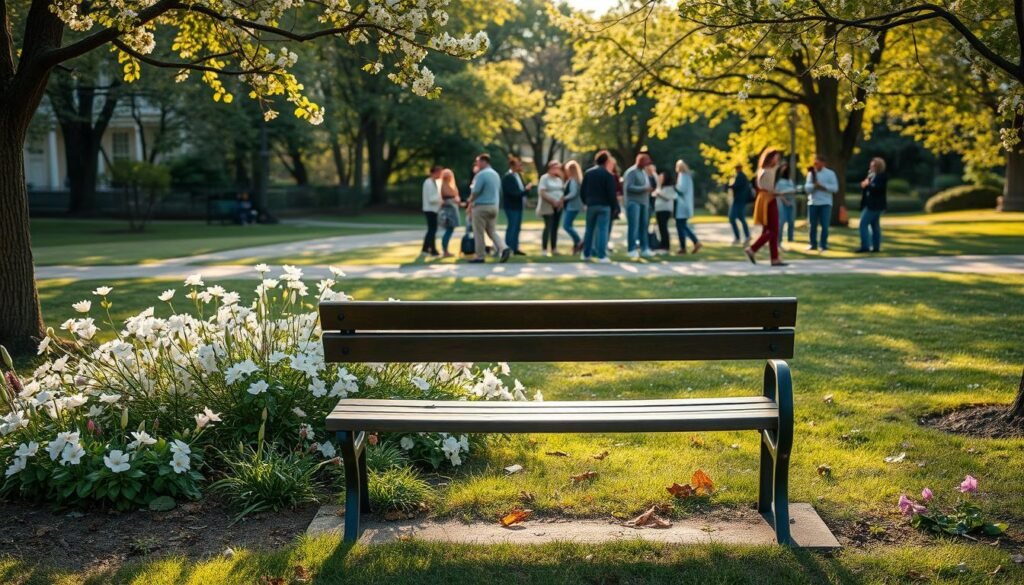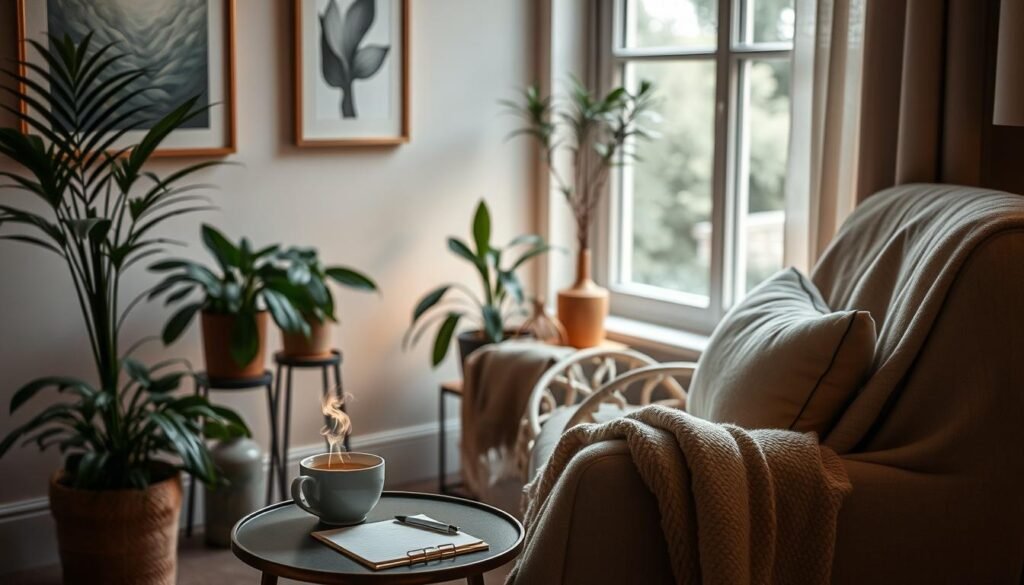Did you know about 7% of people suffer from social anxiety disorder? It’s a common issue, showing how vital effective therapy is. These treatments help people feel more confident and better in social settings. There are many ways to tackle social anxiety, so individuals can find what works best for them. Learning about the different therapies is a critical step for anyone looking to improve.
Key Takeaways
- Social anxiety disorder affects about 7% of the population and can significantly impact daily interactions.
- Cognitive behavioral therapy (CBT) is widely recognized as an effective treatment method for social anxiety.
- Selective serotonin reuptake inhibitors (SSRIs) like paroxetine and sertraline are common first-line medications.
- A combination of psychotherapy and medication often yields the best results for managing social anxiety.
- Support groups and alternative therapies can complement traditional treatments to enhance recovery.
Understanding Social Anxiety Disorder
Social anxiety disorder, or social phobia, affects many people in the U.S. each year. It causes a profound fear of being around others and being judged. Knowing about social anxiety disorder is vital. It helps those affected as they notice symptoms and seek treatment early.
What is Social Anxiety Disorder?
Social anxiety disorder means being extremely afraid of social situations where others might judge you. This fear can make someone avoid social events, feeling isolated and upset. Up to 13% of people might face social anxiety disorder symptoms in their life.
Signs and Symptoms of Social Anxiety Disorder
Signs of this disorder include:
- Excessive worry about being judged or embarrassed in social situations.
- Physical symptoms such as trembling, blushing, or sweating.
- Avoidance of gatherings or fear of meeting new people.
- Difficulty speaking up in group settings or leveraging small talk.
These signs can hurt how a person functions every day and their life quality. Many with social phobia wait over ten years to get help. Spotting these signs early is the key to beginning recovery.
| Sign/Symptom | Description |
|---|---|
| Excessive Worry | Persistent anxiety regarding social situations. |
| Physical Reactions | Symptomatic responses like blushing or sweating. |
| Avoidance Behaviors | Evading social engagements to escape discomfort. |
| Communication Difficulties | Struggles with effective interpersonal communication. |
Understanding social anxiety disorder is key for those affected and their families. It shows the importance of getting professional help for treatment. This understanding can truly make a difference.
Diagnosis of Social Anxiety Disorder
A comprehensive mental health evaluation is needed to diagnose social anxiety disorder. It’s done by a qualified healthcare provider. This assessment is key to understanding the condition. It helps find the best treatment for those with symptoms.
The diagnosis process involves several steps. These steps gather important information to identify social anxiety disorder.
How Diagnosis is Made
For evaluation of social anxiety, a physical exam is first. This is to check for any medical conditions that look like anxiety. After the physical exam, the provider talks with the patient. They discuss the symptoms, how often they occur, and their effect on daily life.
Self-report questionnaires are also used. Tools like the Social Phobia Inventory and the Liebowitz Social Anxiety Scale measure anxiety in social situations.
Importance of Professional Evaluation
Getting the right diagnosis is crucial. It ensures that people get the treatment they need. Understanding the criteria in the DSM-5 helps judge the severity of anxiety. It also looks at how much it disrupts life.
A professional evaluation can confirm social anxiety disorder. It also checks for other conditions that might be present. With social anxiety disorder affecting 5 to 10% of people worldwide, early help can make a big difference in mental health and well-being. For more information, check out resources on social anxiety disorder.
| Criteria for Evaluation | Description |
|---|---|
| Physical Examination | To rule out other health issues that may resemble anxiety symptoms. |
| Discussion of Symptoms | Assessing frequency, duration, and impact on everyday life. |
| Self-Report Questionnaires | Utilizing standardized tools like the Social Phobia Inventory to measure anxiety levels. |
| DSM-5 Criteria | Applying specific diagnostic criteria to confirm social anxiety disorder. |
Therapy for Social Anxiety
Social anxiety can be tough, but therapy can really help. Psychotherapy is key to treating it well. There are various therapy types, each with its own anxiety therapy techniques. They help people handle or reduce their social fears.
Getting to know these methods helps those with social anxiety find the best help.
Types of Psychotherapy
There are a few psychotherapy kinds to ease social anxiety symptoms. These are:
- Cognitive Behavioral Therapy (CBT): It focuses on changing negative thought patterns causing anxiety. It’s shown to be especially good for social anxiety.
- Exposure Therapy: This is used with CBT. It lets people slowly face their fears which lowers their avoidance actions.
- Group Therapy: It offers a chance to improve social skills and get support from others who understand.
Role of Cognitive Behavioral Therapy (CBT)
Cognitive Behavioral Therapy (CBT) is a top treatment for social anxiety. Research says CBT helps people see and tackle the bad beliefs that make them anxious. It uses techniques like learning about anxiety, reshaping thoughts, and facing fears slowly.
CBT’s goal is to give people tools to deal with anxiety. It tackles the way they think and the physical signs of anxiety in social settings. This process helps people face their fears and boost their social skills. For more info on dealing with social anxiety, check this useful resource.
Exposure Therapy as a Treatment Option
Exposure therapy is key in treating social anxiety. It uses exposure-based CBT to slowly face fears. This process helps people deal with their anxieties safely. The main aim is to lessen fear, boosting confidence in social settings.
What is Exposure-Based CBT?
Exposure-based CBT is a form of therapy for social anxiety disorder. It involves facing anxiety-causing situations, like public speaking. Studies show its effectiveness, particularly in reducing anxiety. For example, using virtual reality to reduce public speaking fears proved successful, with lasting results.
Benefits of Gradually Facing Fears
Facing fears gradually teaches people how to cope. It addresses specific fears, like dining out. Services like Talkspace make therapy accessible from home, easing the process.
| Type of Exposure Therapy | Description | Benefits |
|---|---|---|
| In Vivo Exposure Therapy (ET) | Direct confrontation of real-life scenarios. | Immediate feedback and engagement with triggers. |
| Virtual Reality Exposure Therapy (VRET) | Simulation of feared situations in a virtual environment. | Safe and controlled exposure without real-world risks. |
| Online Exposure Therapy | Access to exposure-based CBT virtually. | Flexibility and comfort in treatment settings. |

Medication Options for Social Anxiety
Medication is key in treating social anxiety disorder. It’s often used with psychotherapy. Various treatments are available, and some drugs particularly help with symptoms.
First-Line Medications: SSRIs and SNRIs
Selective serotonin reuptake inhibitors (SSRIs) are usually the first choice. Examples are paroxetine (Paxil) and sertraline (Zoloft). SSRIs boost serotonin in the brain. This can improve mood and lower anxiety.
Serotonin-norepinephrine reuptake inhibitors (SNRIs) like venlafaxine (Effexor XR) are also effective. SNRIs work on serotonin and norepinephrine. They help reduce anxiety and enhance emotional health.
Other Medication Choices
There are more options beyond SSRIs and SNRIs. Beta-blockers can help with performance anxiety in social settings. Benzodiazepines offer quick relief but have risks, like dependency.
Understanding the benefits and risks of each medication is crucial. It’s important to talk with a healthcare provider. They can help choose the best treatment for you.
Coping Strategies for Social Anxiety
Addressing social anxiety involves several steps. Effective coping strategies can greatly reduce symptoms and boost well-being. People often use a mix of daily methods and healthy habits to manage their anxiety.
Daily Techniques to Manage Symptoms
Using anxiety management techniques such as deep breathing helps control anxiety’s physical effects. The 4-7-8 breathing technique, done for five minutes, can lessen rapid breathing and increase calmness. Writing in a journal about situations you avoid and outlining steps to face them can also help reduce avoidance.
Practicing mindfulness improves how you cope. Focusing on others rather than oneself during social events can boost confidence. Visualizing success before facing social situations also prepares the mind.
Building Healthy Habits
Creating healthy habits for anxiety is key to long-term well-being. Regular physical activity and eating well help both body and mind. It’s important to stay away from alcohol, as it can make anxiety worse and lower confidence.
Looking into more resources on coping strategies for social anxiety can offer additional help. Celebrating every small win is crucial in managing anxiety. It promotes good habits and motivates further development.

Support Resources for Social Anxiety
Finding help is key in handling social anxiety. These resources allow people to connect with those who understand. This is crucial for sharing stories and learning how to cope.
Joining Support Groups
Being part of a support group helps build a network for battling social anxiety. Members share their journeys and advice. This creates a welcoming community. The Social Anxiety Institute has run groups for 26 years. It’s a safe place for people looking for support. Also, the National Social Anxiety Center provides specialized groups. They use CBT methods to meet individual needs.
Finding Help Through Online Platforms
Online groups are great for those who can’t meet in person. They offer many tools, like audio and video aids, to support your journey. In the 2019 Online Therapy Series by Dr. Thomas A. Richards, you find 25 sessions with community support. This helps members face challenges together. It’s especially useful for Generation Z. They can join in without the stress of face-to-face meetings.
Overcoming Social Anxiety
Beating social anxiety is complex. It blends many methods and strategies. Mindful practices deeply improve emotional health for those with social anxiety. These methods, like meditating, deep breaths, and picturing peaceful scenes, boost calmness. They help control anxiety in social situations too.
Mindfulness and Stress Reduction Techniques
Some people feel more anxious because of certain triggers. This includes speaking in public, meeting new people, or being in the spotlight. Using mindful methods fights these feelings well. For example, taking deep breaths eases the nervous system. It lowers anxiety signs such as a rapid heartbeat and breathing fast.
Also, a body scan meditation makes you aware of body feelings. It lets you deal with discomfort as it comes. Making these stress-lowering tips part of your day helps you be more confident in social settings.
Setting Realistic Social Goals
It’s key to set social goals that you can achieve. This means making big scary social situations into smaller, doable steps. Start with easy things, like saying hi to a neighbor or having a short chat. This builds a base for facing bigger challenges.
Moving step by step reduces avoidance and boosts confidence. Focusing on slowly experiencing social situations gives you more control. It makes navigating social spaces much easier.

Preparing for Your Appointment
Good preparation can make therapy sessions much more effective. People feel less stressed when they sort out their thoughts and documents ahead of time. These vital tips can help make your therapy session better.
What to Bring to Your Appointment
Bringing the correct items can reduce worry and help have a meaningful talk. You should consider bringing:
- Personal notes on symptoms and what you’ve been through
- A list of medications you’re on
- Any past therapy records, if you have them
- Basic info like your age and if you’re in a relationship
- Information on big life changes or tough times
Questions to Ask Your Healthcare Provider
Thinking of questions before your visit can make you feel more in control. Here are several questions worth asking your healthcare provider:
- Which symptoms should I keep track of to see if I’m getting better?
- What are my options for treatment given what I’m dealing with?
- How many sessions will I need, and what happens in them?
- Will there be tasks to do at home to help me improve?
- Can we change my treatment plan based on how things are going?
Getting ready for therapy in these ways helps with clear communication and building a good relationship with your therapist. This can greatly improve your mental health journey.
| Program | Duration | Modules/Sessions |
|---|---|---|
| BounceBack | Approximately 3 weeks wait | 8-16 sessions |
| MindBeacon | 1-2 weeks for enrollment | 8-16 sessions |
| CAB Program | 6-8 sessions | Varies by workbook |
| Tranquility Program | Weekly | 9 modules |
| OSP Program | Ongoing | Varies by distress experienced |
Alternative Treatments for Social Anxiety
People with social anxiety look for many ways to feel better. They often use both alternative and traditional treatments. These methods help them find relief and improve their overall well-being.
Exploring Herbal Remedies and Supplements
Herbal remedies are popular among those trying to ease social anxiety. Chamomile, passionflower, and ashwagandha are well-liked for their calming effects. They can help reduce anxiety. But, talking to a doctor first is important to avoid any risks. This ensures the safety and success of the treatment. A close look at the available treatments can guide better choices.
Complementary Therapies: Yoga and Meditation
Yoga is celebrated for its soothing impact on anxiety. It can make mental health better. Taking part in classes lowers anxiety symptoms, giving people more control over their feelings. Meditation offers ways to be more mindful and emotionally stable. It can lead to better sleep and less tension. Using both yoga and meditation alongside standard treatments can greatly help manage social anxiety.
Conclusion
People dealing with social anxiety have many helpful options. They can choose from therapy or medication. These solutions can really make life better. Tools like the Liebowitz Social Anxiety Scale help figure out how severe the anxiety is. This makes sure people get the specific help they need.
Treatment for social anxiety includes more than just therapy. There are also support groups and ways to manage anxiety daily. Taking these steps helps people feel better about themselves. They start to enjoy being around others more. The path to beating social anxiety offers various choices, showing how important professional advice is.
In wrapping up thoughts on treating anxiety, remember that social anxiety can be overcome. The right help can change lives. It opens the door to enjoying social activities again. This can lead to better experiences in both personal and work life.